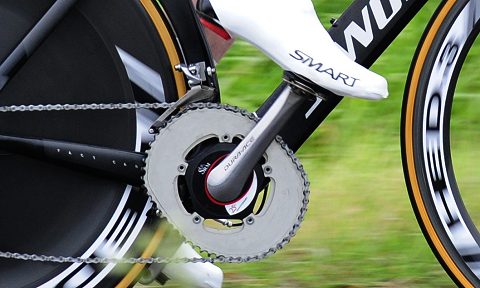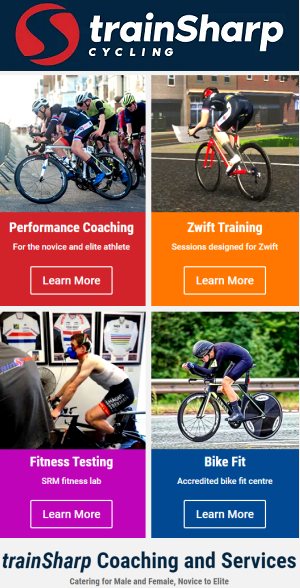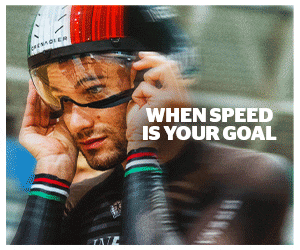Talking with Jon Sharples, head coach at TrainSharp where they help cyclists of all abilities achieve their goals
 |
Coming back into cycling in 1996 at the age of 36, it didn’t take me long to recognise that things had changed since the ‘old days’ when I first raced and needed to train ‘properly’ to get results. So, I enlisted the help of a coach who set out my training for each day of the week.
There was riding for endurance and there was also some intensity ‘intervals’ to help me improve the top end. Overall, I certainly felt it helped me in my racing and almost 20 years on (where did they go!), the value of coaching is much more widely accepted by riders wanting success in whatever sphere of cycling they pursue.
One of the leading coaching companies today is TrainSharp headed up by Jon Sharples and his long-time friend, Tour de France Yellow Jersey, Sean Yates (below). When I went along to their impressive ‘Centre of Excellence’ in the heart of the East Sussex countryside I asked Jon how it all started.
“It was set it up because I have a lot of passion for helping others with their training based around what I found out through personal experience coaching myself. From the age of 16, I was fortunate enough to be around the Brighton University in Eastbourne where I’d see the likes of Peter Keen, Chris Boardman, Stuart Dangerfield, David Millar and other famous names coming in and out, doing their degrees. I was lucky enough to be part of the research programmes that were taking place at that time.
“From an early age, I was told I wasn’t blessed with the genetics to be a cyclist but I was passionate about cycling and not ready to give up on the sport. I’m also the sort of person if someone tells me I can’t do something, I bloody well go ahead and do it. I was always searching for ‘free speed’ because I was advised I didn’t have the physiology to be an endurance monster but I did have a good sprint. I knew if I could get to the finish line, I’d win most races which is how I became a road sprinter.
“Before long I was labelled a ‘sit on sprinter’ and I liked that because I was winning lots of races even though they tried to get rid of me before the finish. Unfortunately, I then damaged my knee and couldn’t sprint anymore and thought that was the end of my cycling days.
Jon during his racing days…
“I took a break from racing and then found that time trialling was okay for my knee which is how I got into the training aspect of the sport because I could see huge rewards for the time actually spent training. It’s a bit like doing some revision and then taking the exam and getting better results because of all the hard work that had been done.â€
“TrainSharp itself was set up by chance really. People were always asking me how to go faster and I was quite happy to tell them and then one day someone said: ‘Will you coach me and I’ll pay you’? This was about eight years ago and I’ve been passionately helping people ever since although I never thought it would take over my life and become a full time job.â€
“Luckily, the success I was having with all my riders and the great relationship I have with them, quickly spread by word of mouth. The business grew, TrainSharp took off and today we have a highly successful business in a sport that we’re still passionate about.â€
The client base for TrainSharp is certainly varied. Many may assume it’s the Elite rider that goes in for coaching but that’s not so. The competitive nature is in us all. Whether it’s a fourth category wanting to be a third cat, a veteran wanting to win his age group or someone wanting to complete a sportive, all types of riders, men and women, are turning to Jon and his team for help.
Doug Dewey winning in France last week, a rider coached by Trainsharp.
Talking about that variety of riders, Jon explains : “To start with, it was about low category riders who wanted to be better at time trialling or road racing. Then, as word spread, people would tell their friends, ‘see Jon, he knows what he’s talking about’, and we started to have a wider range of cyclists.
“Sportive riders came to us as did people who had been told by their doctor that they needed to start exercising and that cycling is good for them because it’s a low impact exercise on the joints and the body. I really enjoy that, helping all manner of riders. That’s what I think I am good at, pitching different training regimes to a whole spectrum of people.â€
One of TrainSharp’s higher profile pupils is Doug Dewey who at the time of talking to Jon had just enjoyed winning a race in France. Medalling in the British Time Trial championships behind Alex Dowsett, Doug is coached by both Jon and Sean Yates in his quest to get a professional contract. He is one of many Elite riders the team look after.
“The Elite riders who fly the flag for TrainSharp are interested in us because they have seen what we are doing with other top end athletes like Doug Dewey,†says Jon. “His brother vetted a lot of people but particularly liked what I was talking about. We had a conference call with Doug and that’s how we started with him. Doug stands out because he is world class.â€
Testing but not down a dual carriageway but going no-where!
Jon goes on to explain how the coaching of Doug, from both him and Sean, is not just about numbers coming from the SRM power cranks; it’s also about a rider’s lifestyle, his racing and his tactics in those races plus, of course, setting goals. Many facets go into making up a successful coaching package right down to the choice of bike.
“I love helping people who want to learn. One of the hardest things to do as a coach is helping those who are well established because they don’t like change. The old school approach of ‘just go ride your bike’ doesn’t work. My question is ‘do you want to just ride your bike or train for more power’ because it’s ‘more power’ that people find hard to train for.â€
“The endurance side of things is just riding your bike and anyone can help you do that but the aspect of learning how your muscles develop and introducing change to make them more powerful, is like an apprenticeship where the rate of change will vary between individuals. There is certainly more to going faster than just the physiology aspect.â€
Jon is keen to stress that one of the most important parts of his coaching is forming a working relationship with the rider because mentally a rider needs to have confidence in their coach and the things they will be asked to do. “First of all, we like to get some data from the rider so it’s a good idea to meet and greet and form a relationship with them as that’s the strongest component of a coach-rider partnership; the strong relationship.
“We’ll then build a rider profile doing some physiology tests and look for their strengths and weaknesses. You can spot a mile away, for example, if they’re not going to be a sprinter. Most road races are won in a sprint and some guys are not there to unleash their sprint while others are there but don’t have a sprint. We can help them try and change things including their mental approach to being more positive on the road.â€
Women in cycling is becoming more and more common these days with numbers up and that is reflected in those looking to be better cyclists and getting coaching. “We have around ten girls that we work with and they’re getting really good results which is exciting for us as coachesâ€.
The Sean Yates factor
Among the coaching staff at TrainSharp is a rider and director sportif who has been at the top of the sport for over 30 years – Sean Yates. A Yellow Jersey in the Tour de France and stage winner in many classic pro events, Sean helped Bradley Wiggins and team Sky take the Tour de France title in 2012. Having such a ‘talent’ in the setup is a big plus for TrainSharp.
“Sean brings to the table a huge depth of knowledge,†says Jon. “We were racing together when he retired from the pro scene and we got on famously. He inspired me to keep developing as a coach and to keep tweaking the training plans. I used him to bounce ideas off as he’s worked with so many different Elite riders and that helps all our cyclists a great deal.
“We talk about race tactics, for example, and things coaches may not even think about that will help the rider. With training plans too Sean knows exactly what will bring a rider on and at the right time, which is so important.â€
As the racing season gets underway Jon explains how it’s the winter time when a rider should look to make the improvements that help them later on. “It’s not too late to get in the base work but they do need to strive to make those cellular changes to produce more power rather than just going out riding with friends.
Sean in his role as DS for Team Sky and one of the men behind Bradley Wiggins Tour de France win in 2012.
“Usually when you start the season and it’s a rider’s first races, they’ll struggle with the attacking and lack that zip that comes later on. It’s important a rider doesn’t peak too early in the season as it’s a long season so they need to be careful to avoid burnout. Over-racing can lead to over-training and their volume will diminish because of that. Their training and racing programme needs to be mapped out and as coaches, we’ll help them monitor the fatigue and maybe suggest using some races as training so they can continue training rather than racing every weekend.â€
“I am a big believer in the fact that you can race too much. Racing can get in the way of training because races can leave riders really tired especially if they have raced with those at a higher level to them. Some then spend most of the next week attempting to recover, trying to fit in some meaningful training which they find tough because there is another race coming up.
“What we’ll do is look at on all their racing and training and work backwards from their goals because it’s important they have those goals and train towards them.â€
The Hurt Locker
Looking to my right, I see an SRM bike set up in what I suspect is a ‘hurt locker’ for so many cyclists. It’s just one of many services that TrainSharp offer including equipment related to coaching and that search for speed. “We’re not a bike shop as such but we do have the things that we believe will help performance like the O.Symetric chain-rings which have been around for some time. They’re a bit like marmite; you either love them or hate them.â€
The SRM and  O.Symetric chain-rings in action, both available from Trainsharp.
“People put them on their bikes and because they feel a bit weird, they go back to round rings and that’s when the penny drops. They realise the hardest part of the pedalling is pulling through the dead spots. These dead spots have been eliminated by the O.Symetric chain-rings. Round rings are wrong for your legs because it’s too easy to press down and too hard to pull through the dead spot. The O.Symetric chain-rings focus on the strongest point of the pedalling which is just pressing downâ€.
TrainSharp also have SRM power cranks because power is king in coaching a rider. Not for nothing do so many pro teams have their riders fitted with SRM power cranks and heart rate monitors. “A power metre is essential if you want to track what you’re doing because heart rate is so variable on a daily basis with temperature changes†says Jon. “The power metre lets us know watts per kilo and where you fit in with everybody else.â€
Jon is keen to stress, though, that the power a rider produces is not the be all and end all. “We’ve seen some guys come in here who are winning races based on what looks like little talent on the bike while others, aerobic monsters, don’t’ read the races as well as they could and therefor, despite the power, don’t always get the result.â€
And that is where TrainSharp fits in to the equation. As Jon explains, it’s one thing having a power metre, it’s quite another being able to use it to become a better bike rider. “They need a coach to help them because the power crank on a bike is like having your coach with you on every ride and every race where we get to see what you’re doing.â€
There is certainly no hiding place for a rider using power cranks and I found myself looking back to the days before power cranks. That was when having just heart rate data to hand over to a coach, made me train a whole lot better than I might otherwise have done. Like the name TrainSharp suggests, Jon, Sean and the other coaches are there to help cyclists sharpen up their training to become better riders. The constant stories of their riders producing PB’s in time trials and so on, is proof that their Centre of Excellence for the man and woman in the street is just that, excellent!
Thanks to Jon and Sean for spending time with us …
Other Results on VeloUK (including reports containing results)
- Features, Reports, Results
- Result: Beverley Town Centre Races
- Hill Climb Championships: Change of Course
- Crit Result: Portsmouth Evening Circuits 11
- Crit Result: RCR FatCreations Goodwood Summer Special
- UK Armed Forces Inter-services Road Race
- Report: TLI Cycling ‘Belgium Training Series
- BMCR RESULT: The Ron Day MK Bowl Circuit races (July 23rd)
- RR Result: Bath RC Junior National Series Road Race
- Crit Result: West Thames League 15
- Crit Result: SACA Salt Ayre Tuesday Series 15
- Crit Result: Bath CC Mid Summer Series 2
- Crit Result: Full Gas Summer Circuit Series #17
- TT Result: Ross-On-Wye & Dist CC 25m TT
- TT Result: Ross-On-Wye & Dist CC 10m TT
- TT Result: Kernow Racing Team 10m TT
- News: Men’s Tour of Britain Route (Stage 1 & 2)
- Youth Result: RL360 Isle of Man Youth League 14
- TT Result: Verulam Cycling Club 25m TT
- TT Result: Manchester & District Ladies CA 25m TT
- TT Result: Ferryhill Wheelers CC 25m TT
- Crit Result: Banbury Star Crit Series #2
- RR Result: Lakes Road Club Summer Road Race
- National Circuit Series: Colne
- TT Result: Kings Lynn CC 15m TT
- TT Result: ECCA 10 mile Time Trial
- TT Result: Chorley Cycling Club 10m TT
- TT Result: Houghton CC 25m TT
- TT Result: Bournemouth Jubilee Wheelers 10m TT
- TT Result: Farnham RC 10m TT
- Crit Result: King&Queen of the Bowl Series #13
- TT Result: Kernow Racing Team 10m TT
- Crit Result: Lichfield/Velospeed No Frills at Curborough #7
- TT Result: Swindon RC & Swindon Wh 50m TT
- Crit News: Spatzwear Friday Night Crit Series #6 | YBC
- GB News: Paracycling Squad for Paris 2024
- Crit Result: Thanks Crit it’s Friday 7
- Crit Result: Omega Portsmouth Circuits 6
- Result: BMCR National Road Bike TT Championship
- Crit Result: Ride Revolution Coaching Summer Crits #2
- Crit Result: Shutt Velo Rapide Hitters Crits Rd2
Other News on VeloUK
- Hill Climb Championships: Change of Course
- TT Result: Ross-On-Wye & Dist CC 25m TT
- News: Men’s Tour of Britain Route (Stage 1 & 2)
- GB News: Paracycling Squad for Paris 2024
- Ribble Redefines Road with launch of Allroad
- BMCR: National Road Bike Time Trial Championship
- SUNDAY: Bath Road Club Junior National Series Road Race
- TLI CYCLING FEATURE: SUPER4SERIES
- NATIONAL CIRCUIT SERIES UPDATE 2024
- News: Josh Tarling Extends Contract at Ineos
- Tour of Britain for Men 2024
- News: Connor Swift Extends Contract with Ineos
- Updated GB Olympic Team News
- Sunday: 2024 Youth Circuit Race Championships (Cyclopark)
- ROBBED BY THE HIGHWAYS AGENCY – National Highways
- Startlist: BMCR National Road Championships E/F/G/H
- OLYMPIC NEWS – Team GB Announces First Riders for Olympics
- News: Alex Richardson Retires
- New Releases from Shutt Velo Rapide
- STARTLIST: Men’s British Road Race Championships
- STARTLIST: 2024 Women’s British Road Race Championships
- Startlist: 2024 CAMS Yorkshire Classic Road Races
- Startlists: 2024 Circuit Race Championships
- Startlist: CAMS Ronde van Wymeswold
- Startlists & 2023 Results: National Time Trial Championships
- NEWS: Star Studded Line Up for National Road Champs
- Riders so far: London Dynamo Summer Road Races
- Women’s Tour of Britain Startlist (provisional)
- News: Lincoln winner hit by car
- Entries Wanted: Ilkley Cycles Races
- GB Team Named for Women’s Tour of Britain
- STARTLISTS: NW, Yorkshire & NE Regional RR Championships
- Startlists: East Midlands Road Race Championships
- News: Ribble Rebellion Race USA’s Armed Forces Cycling Classic
- TT Result: Legato Racing Team 10m TT
- Pre-Race Rider Quotes: Ford RideLondon Classique
- STARTLIST: Witham Wheelers Road Races
- Team News: Tour of Britain for Alba Development RT
- Startlist: Totnes Vire 2024
- Starters: NW Junior/U23 360cycling Two Day

























